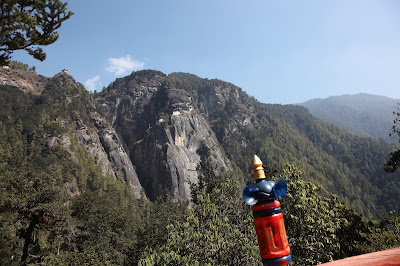Paro, Bhutan: On 24th February 2018, after four days of work, three colleagues and I decided to ascend Taktsang Lhakhang, perhaps the visually best-known sacred site in Bhutan. Often, it is also known as the Tiger’s Nest. For those of us not used to working and exerting ourselves in such high altitudes, climbing 10, 000 feet or 900 meters above sea level to reach the temple via 10 kilometers of rough foot paths and uneven steps is not an easy task. It is on the way down that my Legs began to talk to me, in an annoying, impolite, insistent and unrecognizable accent. They asked, "what the fuck is wrong with you, dragging us without consent relentlessly across this thankless terrain?" As my Legs have never talked to me before, I was not sure if I was delirious or if this was coming from some of the perfectly fit and able Bhutanese pilgrims cruising by or from the out-of-shape Indian tourists panting along.
Legs continued: “Did we complain when one fine morning in 1979 you decided to climb Mount Kosciuszko’s 7309 feet? Did we complain when for no good reason you climbed not once but twice Mount Pidurithalagala’s 8280 feet two years later? We never did. Not that you ascending these mountains made any difference to anyone. Have we complained when you have dragged us across the world over the last 56 years, across oceans, continents, islands, jungles, deserts, rivers and what not?”
I looked down, dusted my boots, and asked my legs to relax. After all, they were not the only ones this severely taxed that day. The heart was complaining too in its silent grumpy way, huffing when it should not and puffing when it should not. I was trying to be patient. After all, they have been my faithful companions for over five decades when many others have simply come and gone without even leaving a faint trace in what remains of my memory? So I asked them, “why should I not climb that mountain to reach the place where the most iconic temple in Bhutan clinging to the cliff face was built in 1692?”
I tried to offer both historical and anthropological reasons as any reasonable scholar would to explain why this adventure made sense: “Listen, the temples in the complex have been built around a cave where in the 7th century AD Master Rimpoche is believed to have meditated for 3 years, 3 months, 3 days and 3 hours. And that was to defeat demons with bad intentions living in the vicinity.” The Legs, were not impressed. They retorted: “But Master Rimpoche did not drag a set of antique feet to get to Taktsang as you have done. He being a master and an enlightened person, simply flew there on the back of a tigress. That is what sensible people do.”
I tried to reason out with commonsense as anthropology and history had obviously failed: “Listen, I don’t have the power to fly on the back of tigers or atop any other known creatures. The place also does not have a helipad. All I can do is to walk and see the place considered very sacred by local people, where many saints have meditated since the time of Master Rimpoche.” Legs remained steadfastly unhappy and uttered the kind of colorful but nasty epithets that cannot be reproduced even in the jungles of social media. I thought of offering them some religious reasoning: “nothing in the Buddhist scheme of things is easy. Life itself is full of suffering and needs to be overcome by trying over many lifetimes, over eons. You know quite well that is what samsara is all about. Can’t you consider the eight hour trek up and down Taktsang Lhakhang as symbolic of life itself, as symbolic of samsara?” “But I am not Buddhist,” screamed Legs. “I am simply blood, bones and flesh @ 56.”
This was not a conversation that would end well if we continued this way. As a last resort, I thought of offering Legs some of the images captured along the way even though Legs were not known for their appreciation of visuality. But life can be full of surprises.


























